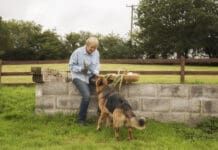Your article Diets and the Older Dog (Whole Dog Journal December 2006), asserting that kidney diseased dogs do need protein, is right on!Before my Whole Dog Journal days, I owned a Sheltie who was diagnosed with kidney disease. In the first stages he started refusing to eat. He had dropped from a lean 28 pounds to 24 pounds. I didnt know what to do so I blended his dog food in with some mixed vegetables. This appeared to work and at his next visit to the vets office he had gained back two pounds.
However my vet recommended the Hills k/d canned diet to me saying that low protein is better for my dog with kidney disease. Instead of listening to my gut instinct, I started feeding the food. When I finally had to euthanize my dog due to his severe kidney failure (while religiously feeding him this diet that was supposed to help him), he died at 18 pounds with no muscle mass on his body at all. He literally looked like a skeleton with skin and fur hanging off of it.
After my Sheltie died I learned two things: listen to your gut instinct and dont listen to your vets diet recommendations unless they go with your gut instinct. Knowledge is key and Im just glad Whole Dog Journal is around for me for the next go around when my Corgi girl grows old!
Tiffany Birkinbine
via e-mail
The excellent article on agility training (Leaping to Attention, December 2006) could have been written about my dog, Hannah. I acquired my two Wire Fox Terriers about 18 months ago, when Hannah was 9 months old and Willie was 12 weeks old. When I got Hannah home, I discovered she was absolutely terrified of everything cars, noises, people, and especially dogs. She would cringe and try to escape, but if a dog got close to her she would snap and lunge at them. I was horrified! I didnt know what to do to socialize her, since its difficult to get other dogs and people to tolerate this.
By chance, I was walking through the fairgrounds nearby and saw a woman putting up an agility course. We chatted, and she suggested bringing Hannah to classes just to watch. I went for two months, twice a week, sitting in the bleachers holding Hannah, who was trembling like a bowl of Jello. After about a month she stopped shaking. After a little while longer she became interested in what was going on, then tried to sniff at the dogs, etc.

288
I then enrolled her in beginning agility, thinking it would give her confidence. Well, it worked! She became the star of her class, and she loves it. Her energy and playfulness have made her a natural. The agility classes were made to order: a fun game, dogs who couldnt care less about her, and therefore posed no threat, an outlet for her energy, and all that positive feedback and encouragement. My other dog, Willie, is good too, but Hannah has been transformed from a fearful dog into a dog bursting with confidence and enthusiasm. And its so much fun for all of us.
Diana Chapman
Ferndale, CA
After reading Shots Fired (November 2006) about vaccines, I want to share my experience using titer testing to satisfy licensing requirements in a state that requires rabies vaccinations.Our dog Molly came to us as a two- or three-year-old stray in 1988. Shes a pit bull mix (maybe with German shepherd?) and a sweetheart. We had her vaccinated for the first time after she recovered from a condition she had when we first found her, salmon poisoning no, not salmonella; salmon poisoning. Its the result of a fluke that dogs get by eating raw salmon in the Pacific Northwest, deadly to most.
My recollection is that she handled that first vaccination okay, but went on to have ever-more-severe reactions over the years. The last time we had her vaccinated, August 21, 2002, she was ill and depressed and our fairly conventional vet prescribed Benadryl. Because of her reactions, the vet and we agreed to skip her next regular rabies shot and then switched to titering in March of 2005, based on your article (Take the Titer Test) in December 2002. Our vet had never done this before for licensing purposes, but read the Whole Dog Journal article at our request and willingly forged ahead.
With the results showing strong immunity, our vet contacted the state veterinarian about using the titer results for licensing. The state vet said the titer results should be sufficient and added that if the county (the actual licensing agency) gave us any trouble to let him know. The county granted us a one-year license (because thats all we asked for) based on the titer and a letter from our vet without question.
We ran another titer in June 2006 and requested a three-year license based on those still very strong results. No problem; license issued.
So, those who live in states requiring rabies vaccinations may find that the vaccine may not be required if you can show strong titer test results and a history of reactions to vaccines. I hope this will be of help to others trying to avoid the overvaccination of their dogs. Who knows? We may end up educating the licensing community and changing state laws.
Carol VanHouten
Sheridan, OR






